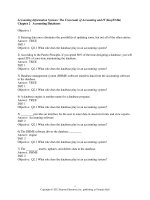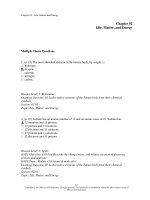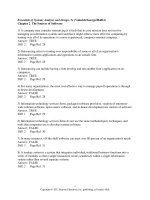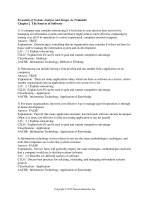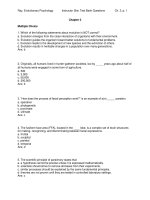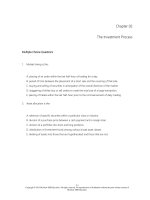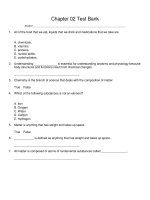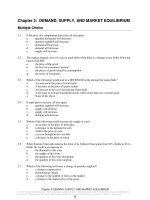Psychology of thinking (psychology of emotions, motivations and actions) 1st edition {PRG}
Bạn đang xem bản rút gọn của tài liệu. Xem và tải ngay bản đầy đủ của tài liệu tại đây (2.3 MB, 196 trang )
PSYCHOLOGY OF EMOTIONS, MOTIVATIONS AND ACTIONS
PSYCHOLOGY OF THINKING
No part of this digital document may be reproduced, stored in a retrieval system or transmitted in any form or
by any means. The publisher has taken reasonable care in the preparation of this digital document, but makes no
expressed or implied warranty of any kind and assumes no responsibility for any errors or omissions. No
liability is assumed for incidental or consequential damages in connection with or arising out of information
contained herein. This digital document is sold with the clear understanding that the publisher is not engaged in
rendering legal, medical or any other professional services.
PSYCHOLOGY OF EMOTIONS,
MOTIVATIONS AND ACTIONS
Additional books in this series can be found on Nova‘s website at:
/>=Psychology+of+Emotions,+Motivations+and+Actions
Additional E-books in this series can be found on Nova‘s website at:
/>Psychology+ of+Emotions,+Motivations+and+Actions
PSYCHOLOGY OF EMOTIONS, MOTIVATIONS AND ACTIONS
PSYCHOLOGY OF THINKING
DAVID A. CONTRERAS
EDITOR
Nova Science Publishers, Inc.
New York
Copyright © 2010 by Nova Science Publishers, Inc.
All rights reserved. No part of this book may be reproduced, stored in a retrieval
system or transmitted in any form or by any means: electronic, electrostatic, magnetic,
tape, mechanical photocopying, recording or otherwise without the written permission
of the Publisher.
For permission to use material from this book please contact us:
Telephone 631-231-7269; Fax 631-231-8175
Web Site:
NOTICE TO THE READER
The Publisher has taken reasonable care in the preparation of this book, but makes no
expressed or implied warranty of any kind and assumes no responsibility for any errors
or omissions. No liability is assumed for incidental or consequential damages in
connection with or arising out of information contained in this book. The Publisher
shall not be liable for any special, consequential, or exemplary damages resulting, in
whole or in part, from the readers‘ use of, or reliance upon, this material. Any parts of
this book based on government reports are so indicated and copyright is claimed for
those parts to the extent applicable to compilations of such works.
Independent verification should be sought for any data, advice or recommendations
contained in this book. In addition, no responsibility is assumed by the publisher for
any injury and/or damage to persons or property arising from any methods, products,
instructions, ideas or otherwise contained in this publication.
This publication is designed to provide accurate and authoritative information with
regard to the subject matter covered herein. It is sold with the clear understanding that
the Publisher is not engaged in rendering legal or any other professional services. If
legal or any other expert assistance is required, the services of a competent person
should be sought. FROM A DECLARATION OF PARTICIPANTS JOINTLY
ADOPTED BY A COMMITTEE OF THE AMERICAN BAR ASSOCIATION AND
A COMMITTEE OF PUBLISHERS.
LIBRARY OF CONGRESS CATALOGING-IN-PUBLICATION DATA
Contreras, David A.
Psychology of thinking / editor, David A. Contreras.
p. cm.
Includes index.
ISBN 978-1-61728-029-0 (eBook)
1. Thought and thinking. I. Title.
BF441.C66 2010
153.4'2--dc22
2010012270
Published by Nova Science Publishers, Inc. New York
CONTENTS
Preface
Chapter 1
Chapter 2
Chapter 3
Chapter 4
Chapter 5
vii
Learning to Teach the Cognitive Skills and
Emotional Dispositions Required in the 21st Century
Christy Folsom
1
A Rational Expectations Analysis
of Decision-Making
Andrea Migone
39
Structuring Thought: An Examination of Four
Methods
Michael J. Hogan and Zachary Stein
65
Obstacles: Their Impact on Thinking and Beyond
Thinking
Janina Marguc, Gerben A. van Kleef
and Jens Förster
New Thinking about Thinking and Ramifications
for Teaching
Terence Lovat
97
121
Chapter 6
New Thinking for Social Marketing
Susana Marques
139
Chapter 7
Translating Design Thinking for Scientists
Cindy Beacham
155
Index
171
PREFACE
Psychology has long influenced our thinking about teaching and learning.
However, earlier influences of psychology on education were more about not
thinking than what we now consider to be the thinking processes necessary for
life and work in the 21st century. The narrow boundaries of behaviorism have
given way to the complexities of critical thinking, creativity, analysis,
connection making and the self-management skills of decision-making,
planning and self-evaluation. This book focuses on raising the awareness of
scientists and other readers to a form of thinking called design thinking, as
well as major findings regarding the affective, motivational and cognitive
consequences of insurmountable obstacles and their impact on the thinking
process.
Chapter 1- Psychology has long influenced our thinking about teaching
and learning. However, earlier influences of psychology on education
(Thorndike, Watson, Pavlov, and Skinner) were more about not thinking than
what we now consider to be the thinking processes necessary for life and work
in the 21st century. The narrow boundaries of behaviorism have given way to
the complexities of critical thinking, creativity, analysis, connection making
and the self-management skills of decision making, planning, and selfevaluation. Additionally, our 21st century world requires social-emotional
skills that support collaboration, respectful communication, and an openness to
diversity. These expanded skills are expected to be part of each student‘s
education.
This new landscape of teaching and learning goes beyond traditional
practice and requires different and strenuous intellectual demands. Learning
new ways of thinking and teaching presents a challenge for teachers who have
more traditional classroom expectations. Since few have experienced this kind
viii
David A. Contreras
of learning in their own schooling, teachers and teacher educators need
opportunities to gain understanding and mastery of these complex processes.
In addition, and often more difficult, is learning to design and implement daily
lesson plans and long-term units that consistently provide opportunities for
students to develop complex thinking processes.
Teachers and teacher educators need a framework that clarifies the
thinking and emotional components that form the infrastructure of 21st century
learning and teaching. The TIEL Curriculum Design model provides such a
framework making these complex thinking and emotional processes accessible
to teachers and to their students. TIEL, an acronym for teaching for intellectual
and emotional learning, is a synthesis of the thinking operations from
Guilford‘s Structure of Intellect theory and Dewey‘s writings on qualities of
character.
This chapter will address three questions: How has psychology influenced
education during the last century? Why is there so little evidence of the
integration of thinking and social-emotional learning into the curriculum and
instruction in many classrooms? What is the TIEL model and how can it help
pre-service and in-service teachers design learning experiences that integrate
thinking skills and emotional learning into daily classroom curriculum?
Chapter2- I argue that policy-makers rather than using a single decisionmaking modle employ, depending on the situation, flexible decision strategies.
The flexibility of Rational Expectations allows for the modeling of 'forward
thinking', informed actors, and gives them the ability (and potential) to act
strategically by modifying their policy according to the changes in the issue at
hand. Incrementalism, synopsis and punctuated equilibrium can be modelled
using rational expectations and policy-makers can employ them according to
their needs and preferences.
Chapter3- A fundamental thinking skill is the ability to see the structure of
thought. Awareness of the structure of thought begins with an intuitive
description of the elements and relations that constitute a decision-making
process and a description of the relationship between the structure and
function of thought. Regardless of how one judges the quality of everyday
decisions in light of the goals being pursued, it is useful, as a first step, to
construct a structural map of everyday decision-making processes. This allows
for objective analysis of everyday decisions and it enhances structural
awareness in those who map the thinking process and in those who read the
maps. The same applies to scientific thinking. Scientists advocate a particular
position in the academic field and explicit mapping of their arguments
enhances structural awareness, critical comparison and evaluation, and
Preface
ix
communication in the field. Overall, the mapping of decision making is a
worthwhile goal, a skill that is becoming increasingly prominent and even
necessary as part of expert decision making in many fields of applied science.
This chapter presents a case for the cultivation of graphicacy skills in this
context. We describe four thought mapping techniques that offer considerable
power and potential to elucidate and enhance thinking and decision making
abilities. We suggest that technological advances may allow us to merge
various different though mapping techniques and further enhance an
interdependent set of graphicacy skills that may help to support decision
making and adaptive action in context.
Chapter4- People encounter myriads of obstacles throughout their lives.
Those can be big or small, such as a fallen tree blocking the road to work or
life circumstances that make it hard for an adolescent to obtain a university
degree. What are the effects of such obstacles? Could it be that obstacles have
an impact beyond the very task or goal people with which they interfere? The
present chapter reviews major findings regarding the affective, motivational,
and especially cognitive consequences of insurmountable obstacles on the one
hand and potentially surmountable obstacles on the other hand. It also
introduces new findings that show how obstacles influence the more basic
ways in which people perceive and conceptually process information from
their environment. Finally, it highlights possible directions for future research
and discusses the role of people‘s cognitive responses for dealing with life‘s
obstacles.
Chapter5- Since the early 1990s, there has been a concentration of effort
aimed at maximizing student achievement in school education and rectifying
the debilitating effects of failure. In 1994, a Carnegie Corporation Taskforce
on Student Achievement drew on new research in a variety of fields, including
the emerging 'new neurosciences', to refute the narrow assumptions and
findings of conventional educational research and to assert that effective
learning requires a response that is as much about affect and social dynamics
as about cognition. In so doing, it challenged the erstwhile dominant thinking
about thinking and its ramifications for teaching, re-defining learning to
incorporate into the notion of 'intellectual depth' matters of communicative
competence, empathic character and self-reflection as being at least as
significant to learning as the indisputably important technical skills of recall,
description, analysis and synthesis. The chapter will explore the research
findings of the new neurosciences and the implications of their new thinking
about thinking for effective teaching. It will draw especially on a range of
research insights into effective teaching based on application of these findings,
x
David A. Contreras
including drawing on data from a number of research projects from the
Australian Government's Quality Outcomes and Values Education Programs.
Chapter6- This article establishes that a new way of thinking is needed in
the field of social marketing and that change demands a shift from
transactional to relational thinking. Social marketing is still dominated by
prescriptive interventions; however, this transactional logic is incapable of
responding to the complexities of contemporary multi-option, pluralist
societies, in which there will be no universal agreement on a single way of life.
Relational thinking can help to de-construct the taken-for-granted ―truths‖ and
fundamental contradictions in current thinking as it provides a new logic that
sees consumers not as targets, but as the main drivers of the value creation
process. The shift from transactional to relational thinking opens new
opportunities, new challenges and has deep implications for the theory and
practice of social marketing. It is a complex shift that requires fundamental
changes not only in values and assumptions but also on resources, skills,
competencies and organizational structures.
Chapter7- Historically, design has been viewed as an activity for design
professionals. Typically, the focus of design has been the intentional creation
of products, structures, or systems to address the needs of firms and
individuals. Why should scientists be interested in design? One reason is an
ethical one, as twenty-first century realities may require the participation of
everyone to have a say in our designed world. The overall purpose of this
chapter is to raise the awareness of scientists and other readers to a form of
thinking called design thinking. The term has been familiar to many design
disciplines and most recently has been touted by members of the business
community as a mindset for an entire organization. One of the sub-disciplines
of design is that of design management, providing guidance on the use of
design thinking across the entire organization. The first section of this chapter
will review the design thinking literature across different levels of activity,
including design and society, design and organizations, design and education,
and design and the designer. The second section will suggest ways to help
scientists understand and use design thinking. What is a scientist to do with
this information? This section will be organized in three sub-sections; namely,
understanding design thinking, the relevance of design thinking, and
envisioning the future.
In: Psychology of Thinking
Editor: David A. Contreras, pp. 1-38
ISBN 978-1-61668-934-6
© 2010 Nova Science Publishers, Inc
Chapter 1
LEARNING TO TEACH THE COGNITIVE
SKILLS AND EMOTIONAL DISPOSITIONS
REQUIRED IN THE 21ST CENTURY
Christy Folsom
Lehman College, City University of New York, NY, United States of
America
ABSTRACT
Psychology has long influenced our thinking about teaching and
learning. However, earlier influences of psychology on education
(Thorndike, Watson, Pavlov, and Skinner) were more about not thinking
than what we now consider to be the thinking processes necessary for life
and work in the 21st century. The narrow boundaries of behaviorism have
given way to the complexities of critical thinking, creativity, analysis,
connection making and the self-management skills of decision making,
planning, and self-evaluation. Additionally, our 21st century world
requires social-emotional skills that support collaboration, respectful
communication, and an openness to diversity. These expanded skills are
expected to be part of each student‘s education.
This new landscape of teaching and learning goes beyond traditional
practice and requires different and strenuous intellectual demands.
Learning new ways of thinking and teaching presents a challenge for
teachers who have more traditional classroom expectations. Since few
have experienced this kind of learning in their own schooling, teachers
and teacher educators need opportunities to gain understanding and
mastery of these complex processes. In addition, and often more difficult,
is learning to design and implement daily lesson plans and long-term
units that consistently provide opportunities for students to develop
complex thinking processes.
2
Christy Folsom
Teachers and teacher educators need a framework that clarifies the
thinking and emotional components that form the infrastructure of 21st
century learning and teaching. The TIEL Curriculum Design model
provides such a framework making these complex thinking and emotional
processes accessible to teachers and to their students. TIEL, an acronym
for teaching for intellectual and emotional learning, is a synthesis of the
thinking operations from Guilford‘s Structure of Intellect theory and
Dewey‘s writings on qualities of character.
This chapter will address three questions: How has psychology
influenced education during the last century? Why is there so little
evidence of the integration of thinking and social-emotional learning into
the curriculum and instruction in many classrooms? What is the TIEL
model and how can it help pre-service and in-service teachers design
learning experiences that integrate thinking skills and emotional learning
into daily classroom curriculum?
INTRODUCTION
School reformers in the 1990s envisioned schools as
Exciting places: thoughtful, reflective, engaging, and engaged ... places
where meaning is made…places that resemble workshops, studios, galleries,
theaters, studies, laboratories, field research sites, and newsrooms…[places of
] shared inquiry [where] students are engaged in initiating and assessing their
ideas and products…feel supported in taking risks and thinking
independently. (Darling-Hammond, 1997, p. xiv)
Such classrooms have thinking at the core of the curriculum and support
healthy social-emotional learning as students learn rigorous content.
The field of psychology has long influenced our thinking about teaching
and learning. The research of many psychologists (Gardner, 1985; Marzano,
1992; Sternberg, 1996; Torrance, 1970) address the thinking processes taking
place in classrooms like the ones just described. However, earlier influences of
psychology on education (Seifert & Hoffnung, 2000; Thorndike, Cunningham,
Thorndike & Hagen, 1991) were often more about not thinking than what we
now consider to be the thinking processes necessary for life and work in the
21st century (Darling-Hammond, 1997; Friedman, 2005; Partnership for 21st
Century Skills; Pink, 2006; Wagner, 2006). The narrow boundaries of
behaviorism have given way to an emphasis on the cognitive complexities of
Learning to Teach the Cognitive Skills…
3
critical thinking, creativity, analysis, connection making, and the selfmanagement skills of decision making, planning, and self-evaluation.
Additionally, our 21st century world requires social-emotional skills that
support collaboration, respectful communication, ethical behavior, and an
openness to diversity. These expanded skills are expected to be part of each
student‘s education (Partnership for 21st Century Skills).
Learning new ways of thinking and teaching presents a challenge for
teachers who have more traditional classroom expectations. Few teachers,
teacher educators, or those who are preparing to teach, have experienced this
kind of learning in their own schooling (Little, 1993; Smith & O‘Day, 1991),
so they need opportunities to gain understanding of and facility with these
complex processes. This new landscape of teaching and learning goes beyond
traditional practice and requires ―different and strenuous intellectual demands‖
(Hammer & Schifter, 2001, p. 442) as well as attention to the moral-ethical
dimension of education (Cross, 2005; Folsom, 2009b; Kohlberg, 1975; Vare,
1979).
Central in this new landscape is learning to design complex curriculum
and implement daily lesson plans and long-term units that consistently provide
opportunities for students to develop complex thinking processes. Complex
pedagogy involves the conscious planning of curriculum and instruction that
integrates the processes that facilitate the development of children‘s
intellectual and social-emotional capacities with subject matter content. The
outcome for students is complex, creative, multidimensional learning (DarlingHammond, 1997; Torrance, 1981; Treffinger, 1980). If students are to be
ready for the complex world in which we live, teaching thinking and fostering
social-emotional development must become integrated into daily classroom
teaching and learning.
Bruner (1965) wrote of the revolution ―in our understanding of the nature
of man, his intelligence, his capabilities, his passions, and the forms of his
growth‖ (p. 114). While psychologists have been at the forefront of this
revolution, the deep understandings of thinking that form the foundation of
this revolution have not been made readily accessible to teachers and teacher
educators (Curry, 1983; Darling-Hammond, 1997; Riding & Sadler-Smith,
1997). Therefore, many classrooms have not reaped the benefits of research in
complex intellectual processes such as self-regulation (Zimmerman, 2002) and
creativity (Folsom, 2009a; Guilford, 1977; Richards, 2001; Torrance, 1981;
Treffinger, Isaksen & Firestein, 1983). Teachers and teacher educators need
assistance in taking up arms in the needed revolution in how teachers teach
and how students learn.
4
Christy Folsom
The TIEL Curriculum Design model, Teaching for Intellectual and
Emotional Learning, is a framework that helps inservice and pre-service
teachers design instruction that includes the teaching of thinking and
emotional learning. In this chapter, I will share how the TIEL Curriculum
Design model, helps teachers and teacher candidates who are preparing to
teach create daily opportunities for students to develop their thinking processes
and increase their social-emotional learning.
Three questions will be addressed: How has psychology influenced
education during the last century? Why is there so little evidence of the
integration of thinking and social-emotional learning into the curriculum and
instruction in many classrooms? What is the TIEL model and how is it helping
pre-service and in-service teachers design learning experiences that integrate
thinking skills and emotional learning into daily classroom curriculum?
INFLUENCE OF PSYCHOLOGY ON EDUCATION
Everyone can think. Costa (2008) reminds us that ―nobody has to ‗teach
us how to think‘ just as no one teaches us how to move or walk‖ (p. 20).
However, researchers have shown that teaching can increase one‘s ability to
think more clearly and insightfully (Beyer, 1991; Lewis & Smith, 1993;
Marzano, 1993; Smith, 1969; Sternberg, 1982, 1997). Yet, since the
development of our current school system in the early part of the 20th century,
classrooms where a wide range of thinking is expected and promoted have not
been the norm. Paradoxically, the early field of psychology contributed to this
state of affairs.
As the new field of psychology gained traction, attention to thinking in
relation to education increased. In the late 19th century, it was believed that
mental ability was developed through the subjects studied in school. In the
early 20th century, Thorndike determined through his research that it mattered
little what was studied as those with the greatest ability would develop their
thinking through any subject. Thorndike‘s theories, published widely and
taught in textbooks, convinced many educators in the first decades of the 20th
century that mental abilities were little affected by school studies, and
furthermore, they did not transfer outside the narrow confines of what was
studied (Ravitch, 2000). Building on the earlier work of Binet, Thorndike
developed intelligence tests that were used to determine what students would
learn Latin and geometry, subjects that were traditionally thought to build
mental acuity and discipline. While some students needed the intellectual rigor
Learning to Teach the Cognitive Skills…
5
for college entrance, a curriculum that fostered thinking was not necessary for
the others (Ravitch).
The new science of education, based on psychological research, set the
stage for schooling that focused on a narrow band of thinking. In the early
20th century, schools were places to prepare a burgeoning immigrant
population with basic skills and the ability to follow directions as they went to
work in factories. Schools were rigid and uninviting places. Nevertheless, at
the same time, educators such as Parker and Dewey advocated schools that
fostered thinking through project work, real-life experiences, and attention to
student interest (Cremin, 1961). In 1936, psychologist Leta Hollingworth
opened a school for highly gifted children in New York City that featured a
curriculum that focused on challenging students‘ thinking as they learned
about their surroundings through investigation and research (Tannenbaum,
1983).
At the middle of the century, Guilford‘s Structure of Intellect theory
expanded greatly on the multidimensional view of thinking that had been
proposed by Thurstone (1947). Guilford‘s three-part theory that included
operations, contents, and products provided a view of learning that involved
five operations of thinking that interact with four kinds of content to result in
six kinds of products. Guilford (1950) opened the way for the study of
creativity, a previously neglected area for psychologists, that initiated new
possibilities for both psychologists and educators (Gardner, 1985; Goleman,
1995; Sternberg, 1985; Torrance, 1981).
Over the last sixty years, the influence of research in psychology on
cognition has grown, while its influence on education has fluctuated. Moseley,
Elliott, Gregson and Higgins (2005) provide a brief history of this time period
placing Piaget‘s theory of cognitive development as the most influential on
education. An emphasis on cognition continued into the 1960s and 1970s, with
a focus on information processing. Those in the field of special education used
this research to design methodologies that addressed strengths and weaknesses
in students‘ cognitive processing. High ability students also benefited from the
research on cognition. During this ―space race‖ period that encompassed the
launching of Sputnik and landing men on the moon, high ability students
benefited from new curriculum designed to foster the critical and creative
thinking of America‘s brightest students (Guilford, 1972; Tannenbaum, 1983).
In the 1970s and 1980s, the two viewpoints overlapped. Educators, at this
time, shifted their attention to behavorism with its emphasis on ―clearly
specified objectives and rewards‖ (Moseley et al., 2005, p. 368). Those in
special education adapted this research to develop programmed learning and
6
Christy Folsom
skills training. While methodologies that focused on control and a narrower
band of thinking was adopted in general education classrooms, educators
concerned with narrowing learning opportunities, sought to provide
intellectual nourishment for academically and intellectually gifted students. As
a result, gifted education, entered its ―halcyon days‖ (Borland, 1996) as
programs with an emphasis on critical and creative thinking proliferated.
During the late 1970s and 1980s, the pendulum swung back to an
emphasis on cognition. The new concepts of executive brain function and
metacognition refocused attention on thinking in learning (Moseley et al.,
2005). During this time, research in the social-emotional and moral aspects of
teaching and learning increased (Gilligan, 1993; Hoffman, 1991; Kohlberg,
1975; Noddings, 1984). The term learning styles, first used by Allport in 1937,
reemerged as an avalanche of research on cognitive learning styles took place
during the 1980s and into the 1990s (Rayner & Riding, 1997). Again, special
education and gifted education led the way in applying this new research on
thinking styles to instruction. Those in special education investigated how
teaching their students the self-regulatory processes of goal-setting, decision
making, planning, and metacognition improved the educational achievement
of children with learning disabilities (Moseley et al.). Educators of gifted
children used the new research in cognition to design curriculum and
instruction methodologies (Renzulli, 1977).
The research on thinking skills, thinking styles, and environments that
support critical and creative thinking in classrooms has increased
exponentially since Guilford‘s work in defining the many dimensions of
thinking. While gifted education and special education embraced the research
that supported methodologies grounded in intellectual processes early, the
concepts and actions of thinking are now addressed in all areas of education—
special education, gifted education, general education—and at all levels of
education (Bransford, Brown & Cocking, 2000; Erickson, 2007; Fink, 2003;
Folsom, 2009a; Handelsman, Miller & Pfund, 2007; Stang, Carter, Lane &
Pierson, 2009; Tomlinson, 1999; Van-Tassel Baska, 1991; Wiggins &
McTighe, 1998).
CURRICULUM AND INSTRUCTION IN CLASSROOMS
Two questions arise. With such voluminous research on thinking, thinking
styles, and instructional frameworks, why is there still so little evidence of
conscious attention to the teaching of thinking and social-emotional learning in
Learning to Teach the Cognitive Skills…
7
many of the classrooms where children of all abilities spend the majority of
their school time? Why is there so little understanding of how to integrate the
teaching of thinking and social-emotional learning into daily curriculum?
While special education and gifted education have long considered
research on cognition important to educating children, general education has
been slower to include much of this research into curriculum planning (Lewis
& Smith, 1993; Marzano, 1993; Underbakke, Borg & Peterson, 1993;
Zimmerman, 2002; Zohar, Degani & Vaaknin, 2001). It is clear that teachers
begin teaching with a knowledge deficit concerning thinking processes and
how to develop learning experiences that integrate the teaching of thinking
with content (Ashton, 1996; Darling-Hammond, 1997; Folsom, 2009a). At
least four reasons for this emerge from the research.
First, teachers lack understanding of the terms higher order thinking and
critical thinking. Zohar (2004) notes that teachers are unable to define
fundamental concepts in critical thinking, do not have a clear knowledge of
which thinking skills students need to learn, and have difficulty explaining
their own thinking. This is not surprising as Cuban (1984) noted that defining
the terms used to refer to thinking is a ―conceptual swamp.‖ Kuhn and Dean
(2004) acknowledge the wide range of definitions, and offer that critical
thinking ―entails awareness of one‘s own thinking and reflection on the
thinking of self and others as an object of cognition‖ (p. 270). Underbakke et
al. (1993) provide another definition. Higher order thinking is ―identifying and
using these operations of thinking [interrelating, selecting, and organizing]‖ (p.
139) with subject matter content. Marzano (1993) names three major skills
involved in higher order thinking: ―self-regulation, critical thinking, and
creative thinking‖ (p. 158). Lewis and Smith (1993) combine concepts from
several definitions with a focus on outcome to construct their definition,
Higher order thinking occurs when a person takes new information and
with information stored in memory interrelates and/or rearranges and extends
this information to achieve a purpose or find possible answers in perplexing
situations. (p. 136)
Second, the beliefs and perceptions of teachers about teaching and
learning can prevent the teaching of thinking in classrooms. Hollingsworth
(1989), in a longitudinal study of teacher preparation programs spanning the
time period before, during, and after the fifth year, found that it is difficult for
preservice teachers to change their beliefs about teaching. She found that those
who came to a teacher education program with the notion that knowledge is
8
Christy Folsom
constructed by the learner through experience could modify their thinking and
actions to the constructivist (Brooks & Brooks, 1993) ideas of the program
more easily than those who came with the view of teaching as transmission of
information.
Zohar (2004) also found that the ability to teach thinking comes up against
beliefs about teaching. His research shows that middle school teachers with a
teacher-directed transmission view of teaching that emphasizes convergent
thinking found it difficult to use constructivist methods that encourage a wider
range of student thinking. Those who understood teaching as linear and
teacher-directed found it challenging to allow students to struggle in solving a
problem or to carry on discussions that helped students come to their own
conclusions.
Another misperception that prevents teachers from integrating thinking
into their instruction is that higher order thinking is only for the highest
achieving and advanced students. Included in higher order thinking are the
self-regulatory skills of goal setting, decision making, planning, selfevaluation, time management, learning strategies, self-evaluation (Folsom,
2009a; Stang et al., 2009; Wehmeyer, Agran & Hughes, 2000; Zimmerman,
2002). All of these self-determination skills are important for students with
disabilities to learn in order ―to live a quality life and assume primary control
and responsibility for myriad life activities‖ (Stang et al., p. 94). Nevertheless,
while these skills are important for all students to learn, necessary for gifted
students, and critical for those with learning disabilities, these self-regulatory
skills are not widely taught in general education classrooms.
A third reason that teaching thinking is not widespread in classrooms is
that the research on thinking, teaching thinking, and thinking styles is
overwhelming. The researchers agree (Zhang, 2002). Many psychologists have
analyzed and synthesized studies to provide clarity (Harpaz, 2007; Moseley et
al., 2005; Rayner & Riding, 1997; Riding & Sadler-Smith, 1997; Underbakke
et al., 1993; Zhang). Yet, as Kuhn and Dean (2004) point out, these studies are
not organized and made available in a way that is accessible to teachers who
have limited time to read and consider research.
There is fourth reason that teaching thinking in classrooms does not match
the proliferation of research on the topic. Teachers have not been adequately
prepared to teach and discuss thinking in their classrooms. Sarason (1982),
was surprised by the missing discussion of thinking and learning in classrooms
he visited. When he asked teachers to explain, they told him that nothing in
their teacher preparation programs had prepared them to address thinking in
their classrooms, and if they had learned, they would not have time in their
Learning to Teach the Cognitive Skills…
9
schedules to include discussions of thinking.
Fortunately, educational organizations make research on thinking
available to teachers. Journals, whose primary audiences are teachers working
in schools, have recently devoted full issues to the integration of thinking into
classroom curriculum (Social Studies, 2008; Education Leadership, 2008).
Yet, learning to integrate thinking into classroom curriculum requires deep
changes in thinking about teaching and learning. It is difficult for teachers to
alter their thinking and teaching methodologies while managing the exigencies
of a classroom filled with thirty children. Time, in short supply for teachers, is
an important factor in learning new teaching skills. In addition, the ―period of
cognitive dissonance while less effective practices are replaced with new
practices or while new practices are integrated with old‖ (Folsom, 2009a, p.
69) is stressful while attending to daily teaching responsibilities.
TEACHER PREPARATION
Learning about the fundamentals of thinking and how to integrate the
teaching of thinking into curriculum and instruction must be introduced
effectively in teacher preparation programs. Teacher education programs
commonly teach constructivist methods that open space for a wide range of
thinking through inquiry, decision making, critical questioning, collaboration,
and reflection (Brooks & Brooks, 1993). Yet, the higher order thinking that
constructivist methods support is seldom made explicit in instruction or visible
in the teaching of curriculum design (Folsom, 2009a; Goodlad, 1990) in ways
that help teachers become conscious of these thinking processes. Underbakke
et al. (1993) emphasize that if ―teacher performance is the most powerful link
to higher order thinking in students, teaching teachers to teach thinking must
become one of the highest priorities of education‖ (p. 138). According to Kuhn
and Dean (2004) understanding what these the higher order thinking skills are
that students need to learn is one of the major ―unresolved problems of
education‖ (Bereiter, as cited in Kuhn & Dean, p. 269).
Adding to the challenge in teacher preparation, Ashton (1996) includes the
social-emotional dimension with the cognitive. In her description of the ―wide
range of ―knowledge and experiences not typically included in teacher
preparation programs‖ (p. 22), she includes (a) interaction of social, emotional,
and cognitive forces in learning; (b) new conceptions of teaching consistent
with this complex view of students; (c) new conceptions of intelligence; and
(d) new conceptions of motivation and assessment. Yet, few teacher education
10
Christy Folsom
programs are providing the knowledge and skills necessary for teachers to
effectively teach these skills and dispositions within the curriculum of the
classroom.
While there is much literature on thinking and the teaching of thinking in
journals focusing on research, gifted education, and special education, there is
comparatively little found in journals that focus on teacher education. Using
the words thinking, thinking skills, teaching thinking, curriculum development
and thinking, I performed a search through 21 journals from the last 20 years
that included Teacher Education in the title. I found eight articles addressing
the teaching of thinking distributed throughout five journals. While titles and
words do not always reveal all that is written on a subject, it is an indication of
the imbalance between the research on teaching thinking and the application in
teacher education.
TIEL: MAKING COMPLEX PEDAGOGY
ACCESSIBLE TO TEACHERS
While both psychologists and educators have realized the close
relationship between the cognitive and psychosocial aspects if learning,
(Fasko, 2001; Hayes, 1977; Zhang, 2002), there has been little help in bringing
these concepts simultaneously into the teacher education process. Teaching for
Intellectual and Emotional Learning (TIEL) provides a framework that
clarifies the thinking and emotional components that form the infrastructure of
21st century learning and teaching. The TIEL Curriculum Design model
makes these complex thinking and emotional processes accessible to teachers
and to their students (Folsom, 2009a).
TIEL, an acronym for Teaching for Intellectual and Emotional Learning,
is a synthesis of the thinking operations from Guilford‘s (1977) Structure of
Intellect theory and Dewey‘s (1964) writings on qualities of character. While
theories and frameworks of thinking and creativity (Bloom, 1956; Gardner,
1985; Moseley et al., 2005; Sternberg, 1984, 1985; Treffinger et al., 1983),
and learning styles (Curry, 1983; Riding & Cheema, 1991; Sternberg, 1985;
Torrance, 1963) contain components of Guilford‘s work, psychologists have
pointed out the limitations of his model (Horn & Knapp, 1973; Sternberg &
Grigorenko, 2001). One criticism that pertains especially to teachers is the
complexity of Guilford‘s model limiting its use as a practical pedagogical
framework. Yet, by deconstructing SI to its component parts, the elements that
Learning to Teach the Cognitive Skills…
11
underlie the intellectual processes of critical thinking, higher order thinking,
and creativity become clearer.
Description of the TIEL Model
The TIEL model is represented by the TIEL Curriculum Design Wheel
(see Figure 1), a graphic organizer that serves as a visual and semantic guide
to the intellectual and social-emotional processes. The contents of the model
are derived from the fields of psychology and educational philosophy. The
model is depicted graphically by a color-coded wheel divided into ten
segments that include five thinking operations from Guilford‘s (1977)
Structure of Intellect Theory and five qualities of character described by
Dewey (1964).
The thinking operations include cognition (research, discovery, gathering
information), memory (recall, remembering, and connection-making),
evaluation (critical thinking, assessment, and the self-management processes
of decision making, planning, and self-evaluation), convergent production,
(developing a product that involves logical thinking, one right answer), and
divergent production, (developing a product that involves creativity, risktaking, and imagination). The social-emotional characteristics or, as Dewey
(1964) referred to them, ―qualities of character‖ (p. 197) include appreciation,
mastery, ethical reasoning, empathy, and reflection.
Components of the TIEL Model
While the underlying theories that form the TIEL model are not new,
connecting the concepts provides a fresh perspective on teaching and learning.
In the following section, I define each of the components of the TIEL model in
more detail; explain the relationship between each intellectual component and
the corresponding social-emotional component; and give examples of
questions that can assist teachers in planning more complex learning activities
for their students.
Cognition and Reflection
Cognition, defined by Guilford (1977) as ―discovering, knowing, and
understanding‖ (p. 48), helps teachers think in new ways about how they will
plan for students to obtain information. Teacher candidates learn to see
planning not simply as sequencing interesting activities, but as a means to help
12
Christy Folsom
students develop the intellectual skills of questioning, gathering information,
observing, and researching that lead to knowing and understanding. Using the
TIEL framework as a guideline for curriculum planning helps teachers ask
themselves important questions as they plan.
Figure 1. TIEL curriculum design model.
How will I plan for students to gather information in ways that will help
them develop understanding? What questions will I ask that will help students
develop a variety of thinking skills? What questions might students ask about
this topic?
Dewey (1964) connected the intellectual skill of observation, important in
acquiring information, to reflection. He stated that ―there can not be
observation in the best sense of the word without reflection, nor can reflection
Learning to Teach the Cognitive Skills…
13
fail to be an effective preparation for observation‖ (p. 196). The TIEL
Curriculum Design Wheel visually reminds teachers to plan opportunities for
their students to reflect on their learning. How can I plan for my students to
reflect on the information and concepts they are learning? How can learning
this content help students learn about themselves? How can I help students
reflect on the intellectual and social-emotional processes of their learning?
Memory and Empathy
Memory is the glue that allows us to use our experiences to learn. Memory
stores information, facilitates recall, and allows us to make connections
between concepts and experiences (Guilford, 1977; Jensen, 1998; Sprenger,
1999; Sternberg, 1985; Wolfe, 2001). The TIEL framework helps teachers
recognize that memory goes well beyond the recall of information and
encourages a broader range of questions. How can this concept be connected
to something that is familiar to the students? How can students develop their
memory skills within this content area? How can I help students make
connections between concepts and thinking processes across multiple subject
areas?
While memory serves us academically, it also forms the well of empathy
in each of us. Dewey (1964) states that the development of human sympathy,
or empathy and caring, is an important ―aim of education‖ (p. 197). Noddings
(2003) states, ―Sharing the suffering of others contributes to our own
fulfillment as human beings‖ (p. 15). Yet, to feel compassion for another
requires that ―one must draw upon one‘s own capacity . . . one‘s own
experience‖ (Jersild, 1955, p. 127). An awareness of memory as an important
source of our feelings for others and for ourselves helps teachers consciously
link the intellectual skills of memory to the emotional development of
empathy. This awareness can help teachers understand more clearly how
students bring experiences that profoundly influence their learning and
behaviors in the classroom. Questions that help teachers reflect on the teaching
of empathy include: How can students develop empathy during this study?
What experiences have students had that will help them develop empathy for
others and for themselves? How can I help the students care deeply about their
work?
Evaluation and Ethical Reasoning
Evaluation and ethical reasoning are central in complex teaching and
learning. The thinking skills included in evaluation include ―comparing and
judging‖ information (Guilford, 1977, p. 128) and ―reaching decisions or
14
Christy Folsom
making judgments concerning criterion satisfaction‖ (Meeker, 1979, p. 17).
The opportunity to choose motivates, opens opportunity for exploring options,
and promotes self-directed learning. Marzano (1993), states that the processes
of decision making, planning, and self-evaluation ―render any activity more
thoughtful and more effective‖ (p. 158) and are necessary for higher-order
thinking to take place. When students learn how to analyze ideas, make
decisions use criteria, formulate a plan to accomplish a goal, and evaluate their
own work, teachers prepare them to ―evaluate how they think and behave well
beyond the classroom‖ (Bain, 2004, p. 94).
The TIEL model makes visible the self-management skills of decision
making, planning, and self-evaluation that are often expected, but infrequently
taught in any explicit way. Teachers can ask themselves questions that insure
that these self-regulation skills are included in their curriculum. Where can
students make decisions within this content study? How can I teach students to
set criteria that will help them evaluate their work? What projects will provide
an opportunity for teaching students how to plan?
Ethical reasoning, or ―unswerving moral rectitude‖ (Dewey, 1964, p.
197), is evaluation anchored by qualities of character. Making ethical
decisions requires the same evaluative skills of setting criteria, weighing
options, planning or evaluating one‘s actions, yet combined with empathy and
appreciation. The TIEL framework reminds teachers to dig deeply into content
and ask the following questions: In the course of this study, where can children
become aware of decisions based on honesty, respect, and fairness? How can I
use group project work to help students develop capacity for ethical
reasoning?
Convergent and Divergent Production
It is useful to discuss the thinking operations of convergent and divergent
production together in order to clarify the importance of balancing these two
kinds of thinking in the classroom. The corresponding qualities of character,
mastery and appreciation will also be discussed together. Guilford (1977)
states that convergent production is a kind of productive thinking that seeks
for ―one correct answer‖ as well as logical and deductive thinking. Divergent
production, on the other hand, involves a broad production of information,
resulting in ―alternative ideas‖ (p. 92) and generating information with an
―emphasis on variety and quality of output‖ (Meeker, 1979, p. 20). Divergent
production, “no minor innovation‖ (Richards, 2001, p. 253) includes the kind
of fluent and flexible thinking students need to succeed in today‘s complex
society. Guilford, however, cautioned about considering convergent
